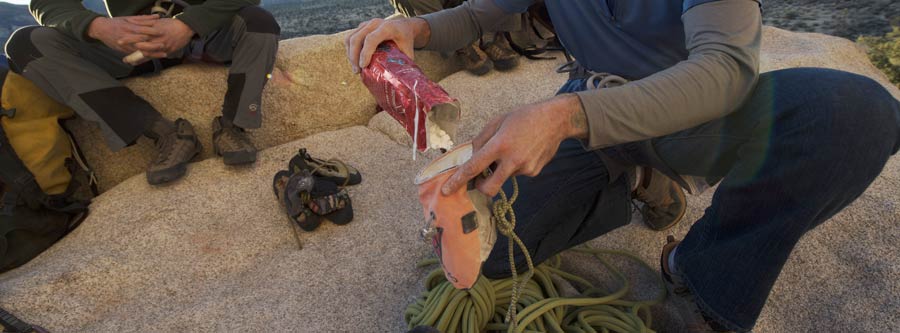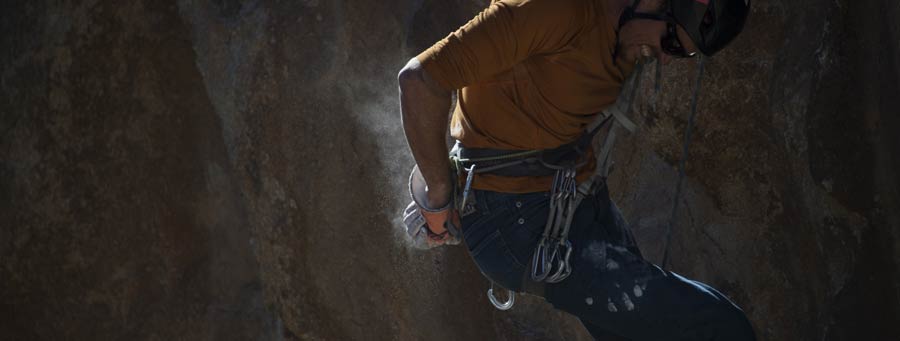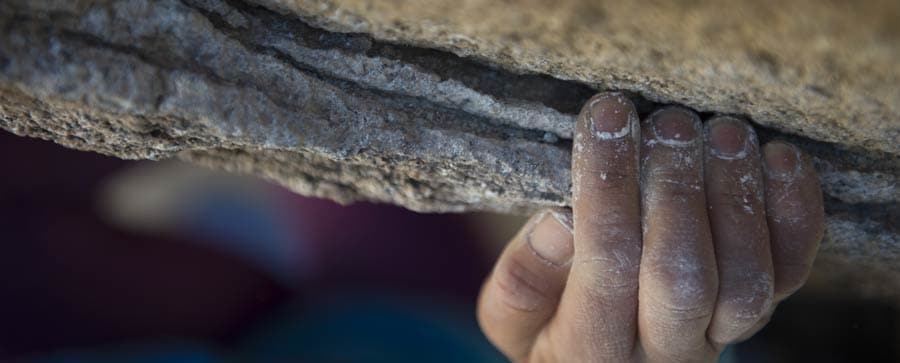Chalk (aka magnesium carbonate, MgCO
) isn't just for gymnasts: Climbers everywhere sport pasty white hands to combat moisture and improve grip.
The good news is that this is one climbing accessory where personal preference rules, and over-analysis isn't needed. It's OK to simply pick chalk by feel and chalk bags by color. This article provides an overview on types of chalk and ways to apply it.
Choosing chalk involves three main considerations:
- Types of chalk
- How you plan to apply it
- What you carry it in
Types of Chalk

Chalk is either pure MgCO3 or an added drying agent is mixed in. Each formulation has its fans. Some welcome the extra drying, while others prefer the feel of pure chalk and would rather not breathe in the added agents. The main difference with chalk is in the form:
- Block chalk is pure chalk in a big hunk. The appeal here is less about cost savings and more that you get to crush it to your preferred consistency. It's also less messy to transport before you crush it.
- Loose chalk includes both pure chalk and chalk with drying agents. The convenience here is that it's already ground for you. Dump it into a chalk bag or ball and you're good to go. Some brands offer finer and coarser grinds.
- Eco chalk is a response to concerns about visually polluting rock surfaces. Consisting solely of a colorless drying agent, it can be an acceptable alternative for gyms or climbing areas where traditional chalk is banned. Wash hands after use, though, because your eyes can be sensitive to it.
- Liquid chalk: After you rub this chalk/alcohol blend on hands, the alcohol quickly dries, leaving a chalk residue. A plus is that it keeps both chalk dust and chalk marks to a minimum.
Application Methods

Unless you have liquid chalk, described above, you use either a loose chalk in a chalk bag or a chalk ball, also carried in a chalk bag.
Chalk bags hold a reservoir of loose chalk that you purchase separately. Plunge your hands in to get a thorough coating.
- Pros: Allows a thicker application.
- Cons: Spills happen.
Chalk balls are made of a porous fabric filled with loose chalk. To apply, simply grab the ball out of your chalk bag and pat it onto your hands. Some chalk balls are refillable.
- Pros: Having an enclosed sack minimizes excess chalk dust and waste.
- Cons: A thick application is hard to achieve.
Chalk Bag Considerations
Bag Size
Though not designated as small, medium or large, bags come in roughly three sizes:
- Small bags are used by people with small hands, weight-wary climbers or those who don't want the bag to hang up when they do technical or dynamic moves.
- Standard bags are the most popular option. Larger sizes work well for routes where you fully coat your entire hands and perhaps forearms (think wide cracks).
- Buckets are ideal for group bouldering sessions requiring a lot of chalk. Instead of being carried on the waist, it sits on the ground for pre-problem dips.
Bag Shape
Waist-mounted bags hang down in two primary shapes. Some are also flat on one side so they hang flush to your body.
- Cylindrical bags: Ideal for longer climbs, they hold a large reservoir of chalk.
- Tapered bags: Suited for shorter sport routes, they're less likely to hang up when you're doing a precise move.
Bag Features
- Stiffened rim: Holds the bag open for easy dipping.
- Fleece lining: Holds down the chalk dust and helps distribute the chalk evenly on your hands.
- Cord and toggle closure: Keeps chalk from spilling between dips and when you stuff the chalk bag inside your gym or gear bag.
- Bag belt: Lets you slide the bag to front or rear for easy access; you can also forgo the belt and clip a bag to your harness, which gives you a backup carabiner.
- Zippered pocket: Can be particularly useful on multi-pitch climbs where you need to store small items like a cell phone, key or lip balm.
- Brush loop: Holds a brush to clean old chalk off holds.
Leave No (Chalk) Trace

Leaving behind chalk smears or visual aids like tick marks is considered very bad form. And if you're generating clouds of dust each time you chalk up, you're overdoing it. Use chalk judiciously, carry a brush and clean up after yourself. And always ask about the local ethic: Some climbing areas forbid the use of chalk altogether.
Always remember: Your safety is your responsibility. No article or video can replace proper instruction and experience. Make sure you're practiced in proper techniques and safety requirements before you climb.

